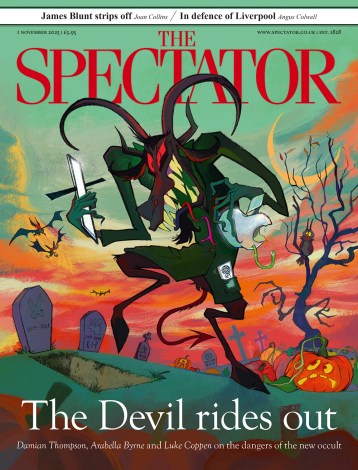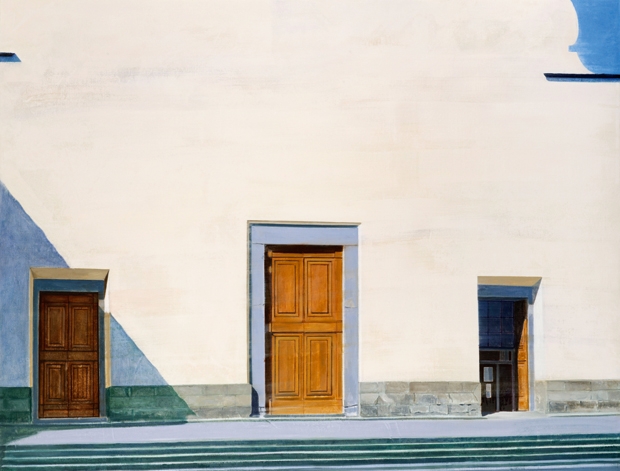One of the paintings in Arturo Di Stefano’s impressive new show at Purdy Hicks Gallery is called ‘Santa Croce’ and it depicts the arcaded cloister of the church in Florence where Giotto painted a series of frescoes. Di Stefano has not chosen to paint the obvious view — its famous black-and-white façade — but focuses instead on the cloister, where he imagines Giotto walking during the making of his frescoes. The painting is thus charged with the human presence of an artist Di Stefano much admires, a hidden presence, though real enough in the frescoed chapels behind the façade of the basilica. This is the kind of thing that Di Stefano would have been thinking about as he worked on his gloriously coloured architectural account of Santa Croce, and this is precisely what gives his paintings their emotional timbre and resonance. Although seemingly unpeopled, they are far from empty.
Di Stefano was born of Italian parents in Huddersfield in 1955, took a Foundation course at Liverpool Polytechnic, before coming to London to study Fine Art at Goldsmiths and the Royal College of Art. He has lived and worked in London ever since, apart from a year in Turin at the Accademia Albertina on an Italian government scholarship, and has exhibited extensively — at the Royal Academy, Tate St Ives, Abbot Hall in Kendal and the Museum of London, as well as a retrospective at the Walker Art Gallery in Liverpool (1993). The first book on his work was published in 2001, but his art is still not as widely known as it deserves to be. With this new show at Purdy Hicks offering a group of paintings of remarkable range and achievement, accompanied by a handsome catalogue featuring an interview between the artist and the internationally respected curator and critic Michael Peppiatt, Di Stefano has reached new heights.
The exhibition begins with a large canvas entitled ‘Santo Spirito’, the façade of another Florentine church, this time a rather minimal one, as the architect’s plans for the façade were never executed. The architect was Brunelleschi, and the basilica’s interior is a fine example of his genius, but there is little indication of this in the somewhat featureless front of the building. Di Stefano has turned this lack of expressiveness to good use and made a painting that is one of his finest achievements and clearly a masterpiece. Steps lead up to three doors (symbolising not only the Trinity, but also Christ on the Cross flanked by the two thieves), which are the main feature of the painting aside from the play of light on stone, and the dramatic fall of shadow on the left. The austerity of the façade allows Di Stefano to indulge in a daringly abstract composition and a large area of subtly modulated cream paint. This could so easily be a boring painting but it is mysteriously ravishing.
His paintings radiate a complexity of emotions. There are two canvases in the show called ‘A Shower of Gold’, both rather abstract and beautiful, depicting the form that Zeus took when he came to seduce Danae in the Greek myth. At first glance, these do not seem to be typical Di Stefano subjects, yet the artist would dispute this. ‘If you look at the way they’re made and the way the other paintings are made, you’ll see they’ve undergone exactly the same process. There’s a painting I did in the late 1980s of Danae, which these refer to, and I was also thinking about what painters do — turning the so-called base material of paint into something valuable; not monetarily valuable, but worth looking at. It’s a painterly process. These were done on a black ground, for instance, so that the final highlights — the yellows, the gold and the ochres — stood out from it. Like all of my pictures, it’s always about the painting. I want you to pay close attention to the visual fact of a painting: its facture, what it’s made of, its fabric.’
The presiding genius of the show is R.B. Kitaj (1932–2007), an artist that Di Stefano admires enormously. A small grisaille head of Kitaj hangs to the left of the gallery entrance, and there are two more paintings that evoke his presence (or rather his absence). A view of the street door of his house in London (entitled ‘Door, RBK & C, London’) and ‘Café, LA’, the table that Kitaj used to sit at every morning in the Coffee Bean bar in Los Angeles after he moved back to America in disgust at the way he had been treated by the critics in this country. Outside the café are newspaper dispensers, on one of which is the word ‘Tod’, part of the title ‘US Today’, but appearing here in its German form, meaning ‘death’. Kitaj, a great loss to art, is still controversial.
For Di Stefano, all paintings are inventions, like the vertiginous space of ‘Tempelhofer Ufer, Berlin’, which resembles a house of cards falling in on itself, a classic instance of distortion. Di Stefano quotes Kitaj quoting Emily Dickinson: ‘Tell it slant’, as a way of revealing a subject to us. He wants people to look again at something they might otherwise take for granted. His paintings are interpretations of what he sees, not some quasi-photographic record of reality, and encapsulate the emotions he feels. So many intangibles then come into play: thoughts, the artist’s personality and personal history, but these are not openly displayed. In some ways, Di Stefano is more English than the English — valuing reserve, tact, discretion. ‘I’m all for decorum, I don’t like clamour. Paintings that shout quickly lose their potency. I remember Ken Kiff when he was my tutor at the Royal College saying, “I just want to whisper something and then go.” It’s the whisper that you’ve got to listen for. People like him are so modest that they are easily drowned out.’
Di Stefano puts in long hours in his East End studio. ‘Gene Kelly, talking about dancing, said: “If it looks like hard work when I’m dancing, I’m not working hard enough.” That applies to painting as well. I love that. It’s got to look effortless, seamless, as if it’s just arrived. Robert Frost described the creative process as being like an ice cube on a stove — “riding on its own melting”. That’s the sort of thing I try to attain when I’m painting.’
In the fruitful transformation of appearances into art, Arturo Di Stefano offers the world back to us in revitalised form; who could ignore the generosity of this transaction?






Comments